How far has panic buying been studied?
S M Yasir Arafat, Fahad Hussain,Sujita Kumar Kar,Vikas Menon, Kum Fai Yuen
S M Yasir Arafat, Department of Psychiatry, Enam Medical College and Hospital, Dhaka 1340, Bangladesh
Fahad Hussain, Department of Pharmacy, Noakhali Science and Technology University, Noakhali 3814, Bangladesh
Sujita Kumar Kar, Department of Psychiatry, King George’s Medical University, Lucknow 226003, India
Vikas Menon, Department of Psychiatry, Jawaharlal Institute of Postgraduate Medical Education and Research, Puducherry 605006, India
Kum Fai Yuen, School of Civil and Environmental Engineering, Nanyang Technological University, Singapore 639798, Singapore
Abstract
Key Words: Panic buying; Systematic review; COVID-19; Pandemic; Disaster; Supply chain
INTRODUCTION
Panic buying (PB) is an interesting behavioral phenomenon, usually noticed among the public in the face of disasters. The term “panic buying” consists of two words “panic” and “buying,” which refer to the affective and behavioral components of this phenomenon. It has some common roots with stockpiling[1]. The coronavirus disease 2019 (COVID-19) pandemic has witnessed an increase in PB behavior globally, irrespective of the socioeconomic status of the country[2,3]. It has been conceptualized as “the phenomenon of a sudden increase in buying of one or more essential goods in excess of regular need provoked by adversity, usually a disaster or an outbreak resulting in an imbalance between supply and demand”[4]. Several intermingled factors interact with each other to influence it, pointed out as primary (provoking stimuli), secondary (media and psychosocial aspects), and tertiary (utility, demand, and price of the goods) factors[2]. Multiple psychological explanations have been proposed such as anticipation of shortage and price hike, supply disruption, fear, uncertainty, maladaptive coping, and maintaining control over the environment to attribute it[2,5-7]. There are complex interactions between media, environment, rumor, and increased demand and price as these factors can have a bidirectional role with PB[2,3,6,8]. It has been traced in response to an adverse stimulus, such as COVID-19, pandemic, war, government’s declaration, any policy change, disaster,etc.[2,9].
Theoretically, PB shares multiple aspects of human life and several domains of academia. It is related to behavior, public health, disaster preparedness, mass media, economics, sociology, business, marketing, supply chain, industrial buying and production, e-commerce, and so on[8]. However, there is a dearth of studies exploring the different aspects of it. Although studies are recently coming out, the issue is still under-researched. With this background, we aimed to conduct a review to assess the extent of research on PB that has been conducted.
MATERIALS AND METHODS
Article search
A search was done to identify the articles in PubMed, PubMed Central (PMC), Scopus, and Google Scholar (GS) with the search term “panic buying” on November 15, 2020. A total of 104 (PubMed = 19, PMC = 22, Scopus = 30, GS = 33) articles were extracted from the initial search. Subsequently, 44 duplicate articles were removed, and the remainder of the 60 articles were screened. After screening the abstract, another 14 articles were removed as PB was not identified as a study variable. Then, full texts were screened resulting in the removal of four articles because the articles only mentioned PB without discussing its aspects. Finally, 42 articles were included in the study (Figure 1).
Inclusion criteria
We included peer-reviewed published articles that were extracted from the search and downloadable as full portable document format in the study.
Exclusion criteria
Articles published in other languages (for example, Bangla, German, Chinese, and French) and preprints were excluded from the study.
Outcome variables
Type of research, publishing year, applied method, key findings, the geographical distribution of the authors, specialty of authors, collaboration (intracountry or intercountry), a major subject of the journal where the articles published, a principal domain discussed in the article, funding status, and keywords were outcome variables. We considered the first authors‘ and corresponding authors’ affiliated institutions’ location to describe the authors‘ geographical locations.
Statistical analysis
In the current study, we asse ssed the aspects of PB research, detail statistical analysis was not performed. We did a word cloud of the keywords of the articles to reveal highlighting search terms mentioned in the articles.
Ethical statement
The study was conducted complying with the Declaration of Helsinki (1964). As we analyzed the publicly available media reports, no formal ethical approval was sought.
RESULTS
Distribution of the studies
In this review, we searched articles from PubMed, PMC, Scopus, and GS, and 42 articles were reviewed. The articles were published between 2002 and 2020 whilst 36 papers were published in 2020 (Table 1). Among the selected articles, 27 were original articles, 6 were correspondences, 3 were commentaries, 3 were review articles, and 1 each were editorial, opinion, and discussion type of articles (Table 1).
Applied methods
Nine studies surveyed the target population online or offline, five studies applied cross-sectional data analysis, four papers studied social media, three studies analyzed media reports, and two studies mined data from Google search volume using Google Trends application programming interface (Table 1).
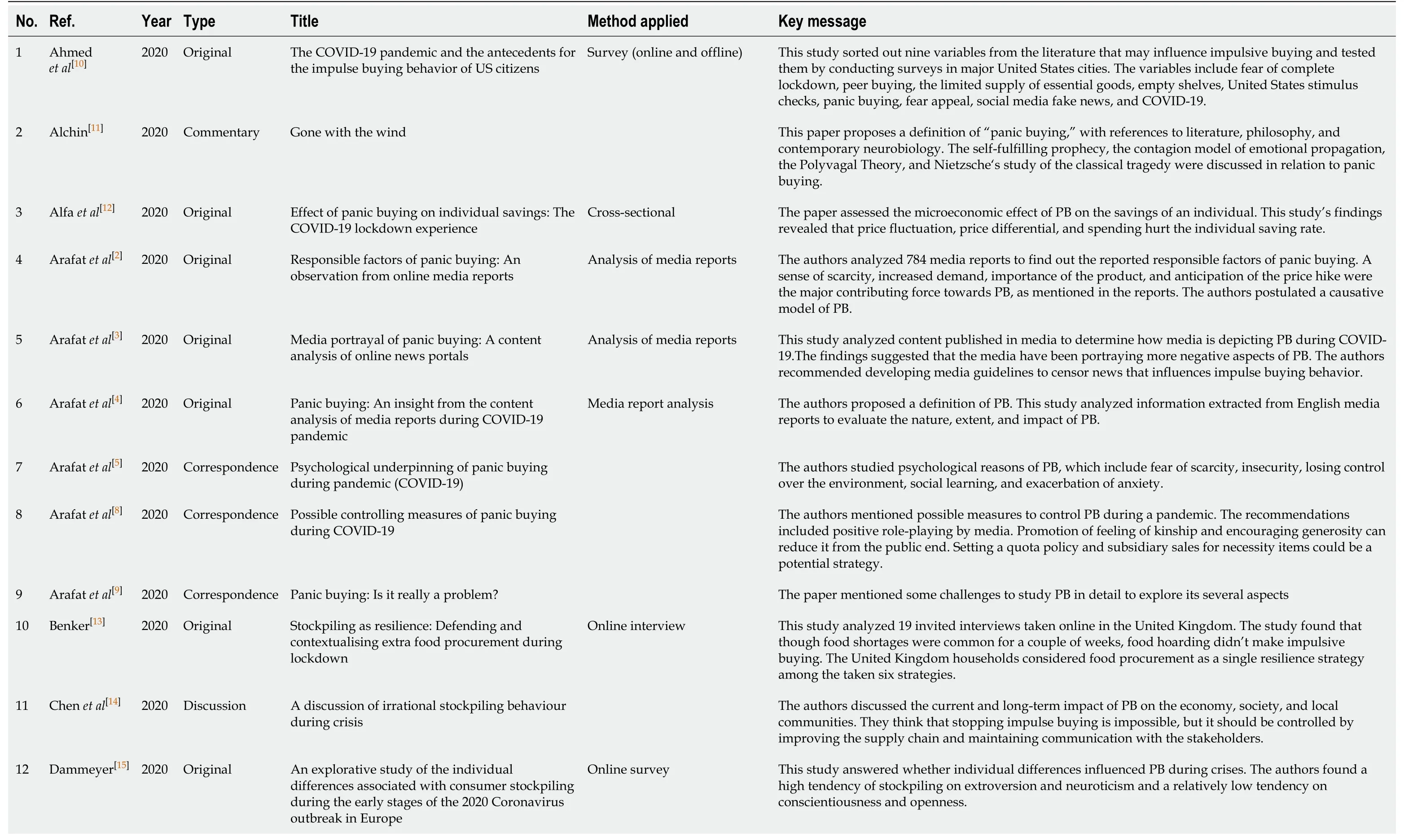
Table 1 Summary of the articles

13 Dickins et al[16]2020 Original Food shopping under risk and uncertainty Authors analyzed super market sales data In this study, the authors showed the importance of food security and suggested optimality models of foraging under risk and uncertainty as foraging correlates to PB.14 Dulam et al[17]2020 Original Development of an agent-based model for the analysis of the effect of consumer panic buying on supply chain disruption due to a disaster Simulation model This study used an agent-based simulation model to analyze how a supply chain responds to consumer PB caused by a natural disaster. The authors found this model useful in applying a quota policy per person to protect the supply chain from disruption.15 Du et al[18]2020 Original COVID-19 increases online searches for emotional and health-related terms Data mining from Google Trends This study measured fear-related emotions, protective behaviors, seeking health-related knowledge, and PB due to COVID-19 prevalence in the United States, the United Kingdom, Canada, and Australia using internet search volumes in Google Trends. The results found that the increased prevalence of COVID-19 was associated with panic buying consistently in all four countries.16 Hall et al[19]2020 Original Beyond panic buying: consumption displacement and COVID-19 Cross-sectional The authors analyzed consumer spending data acquired from financial third parties and found instances of PB for grocery, home, hardware, and electrical categories that happened in the Canterbury region of New Zealand before the lockdown that lasted less than a week. The study showed a high consumption displacement in the hospitality and retailing sectors that dominate this area’s economy.17 Hao et al[20]2020 Original Impact of online grocery shopping on stockpile behavior in COVID-19 Online survey It investigated how online shops affect the food stockpiling manner among urban consumers in China using bivariate probit models. The authors recommended improved and resilient supply chains that can withstand intense PB phenomena during emergencies.18 Islam et al[21]2020 Original Panic buying in the COVID-19 pandemic: A multi-country examination Online survey The authors surveyed 1081 people from United States, China, India, and Pakistan to test their conceptual model and hypotheses. The research revealed that stimuli such as Limited Quantity Scarcity and Limited Time Scarcity affect emotional stress, which eventually influences impulse buying. The findings also correlated excessive social media use to PB and discussed some managerial implications.19 Jeżewska-Zychowicz et al[22]2020 Original Consumers’ fears regarding food availability and purchasing behaviors during the COVID-19 pandemic: The importance of trust and perceived stress Cross-sectional It investigated how the public perception of food availability changed based on the trust in the received information from media and friends. The participants showed less trust in media for COVID updates but high trust in media and friends for food availability updates and increased buying more food than usual. The consumers were highly afraid of empty shelves in the market, which also motivated them to stockpile food.20 Kar et al[23]2020 Correspondence Online group cognitive behavioral therapy for panic buying: Understanding the usefulness in COVID-19 context The authors postulated to explain the usefulness of online group CBT in COVID19 context for controlling the PB.21 Keane et al[24]2020 Original Consumer panic in the COVID-19 pandemic Data mining using Google Health Trends API The authors developed an econometric model of consumer panic using Google search data for 54 countries from January 1st to April 30th, 2020. Findings included limited movement notice announced by local or foreign governments generated a week-long short-run panic. The study found little impact of stimulus offerings and no consumer panic due to travel restrictions. 22 Kostev et al[25]2020 Original Panic buying, or good adherence? Increased pharmacy purchases of drugs from wholesalers in the last week before Covid-19 lockdown Retrospective cross-sectional analysis of the IMS RPM® (Regional Pharmaceutical Market) Weekly database The paper assessed the PB of medication during the COVID-19 pandemic in Germany. The study suggested that Germany’s lockdown was associated with a sharp increase in purchasing behavior in pharmacies for different markets, including psychotropic, neurological, and cardiovascular drugs.23 Laato et al[26]2020 Original Unusual purchasing behavior during the early stages of the COVID-19 pandemic: The stimulusorganism-response approach Online survey The authors conducted a web survey with 211 Finnish participants for a week to test a hypothetical research model. The study found a positive link between voluntary self-isolation and unusual purchases. The online information overload caused cyberchondria, which eventually motivated self-isolation followed by PB.24 Lins et al[27]2020 Original Development and initial psychometric properties of a panic buying scale during COVID-19 pandemic Online survey This study developed the first PB scale that was psychometrically acceptable in the Brazilian context.
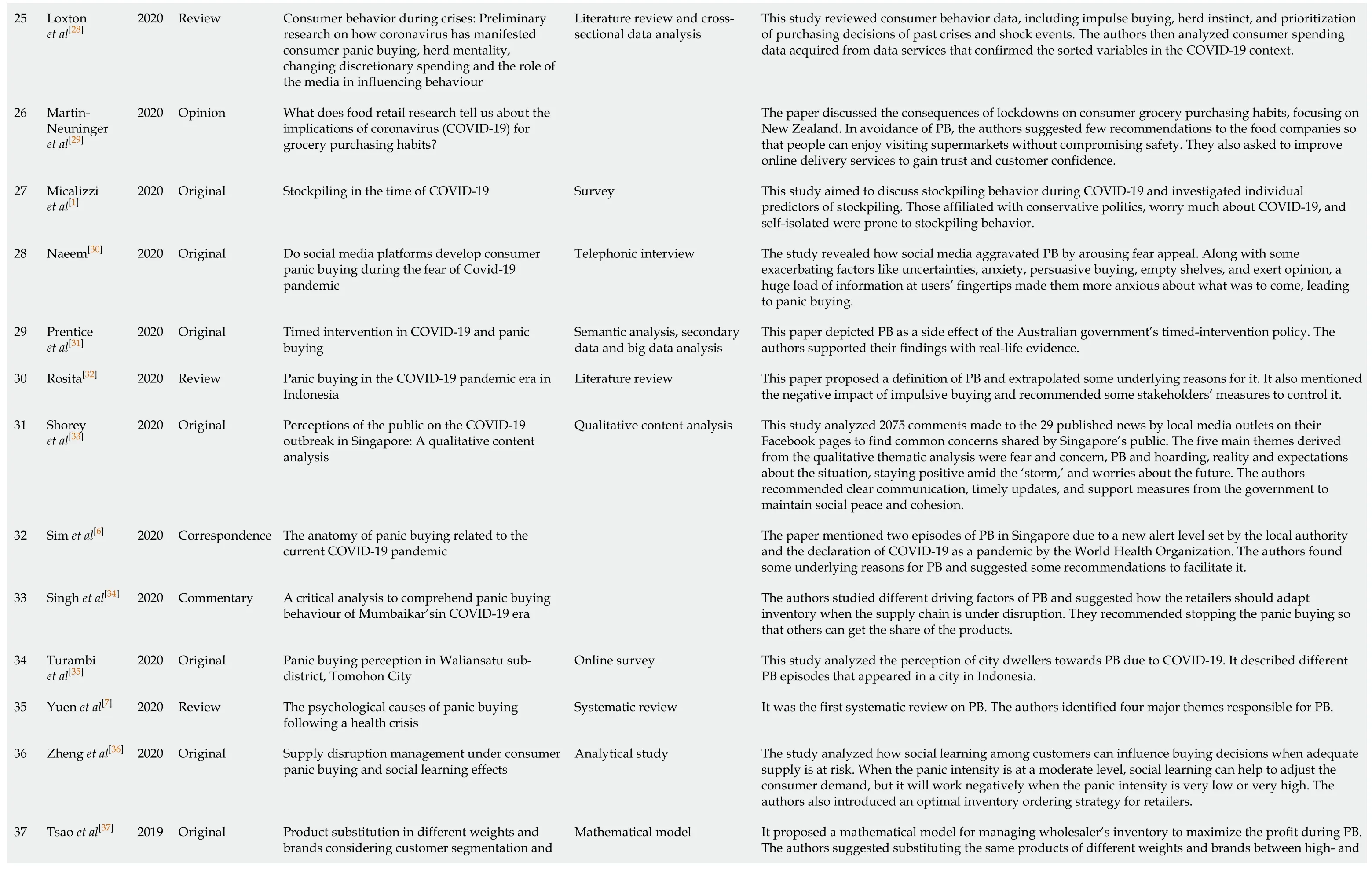
25 Loxton et al[28]2020 Review Consumer behavior during crises: Preliminary research on how coronavirus has manifested consumer panic buying, herd mentality, changing discretionary spending and the role of the media in influencing behaviour Literature review and crosssectional data analysis This study reviewed consumer behavior data, including impulse buying, herd instinct, and prioritization of purchasing decisions of past crises and shock events. The authors then analyzed consumer spending data acquired from data services that confirmed the sorted variables in the COVID-19 context.26 Martin-Neuninger et al[29]2020 Opinion What does food retail research tell us about the implications of coronavirus (COVID-19) for grocery purchasing habits?The paper discussed the consequences of lockdowns on consumer grocery purchasing habits, focusing on New Zealand. In avoidance of PB, the authors suggested few recommendations to the food companies so that people can enjoy visiting supermarkets without compromising safety. They also asked to improve online delivery services to gain trust and customer confidence.27 Micalizzi et al[1]2020 Original Stockpiling in the time of COVID-19 Survey This study aimed to discuss stockpiling behavior during COVID-19 and investigated individual predictors of stockpiling. Those affiliated with conservative politics, worry much about COVID-19, and self-isolated were prone to stockpiling behavior. 28 Naeem[30]2020 Original Do social media platforms develop consumer panic buying during the fear of Covid-19 pandemic Telephonic interview The study revealed how social media aggravated PB by arousing fear appeal. Along with some exacerbating factors like uncertainties, anxiety, persuasive buying, empty shelves, and exert opinion, a huge load of information at users’ fingertips made them more anxious about what was to come, leading to panic buying.29 Prentice et al[31]2020 Original Timed intervention in COVID-19 and panic buying Semantic analysis, secondary data and big data analysis This paper depicted PB as a side effect of the Australian government’s timed-intervention policy. The authors supported their findings with real-life evidence. 30 Rosita[32]2020 Review Panic buying in the COVID-19 pandemic era in Indonesia Literature review This paper proposed a definition of PB and extrapolated some underlying reasons for it. It also mentioned the negative impact of impulsive buying and recommended some stakeholders’ measures to control it.31 Shorey et al[33]2020 Original Perceptions of the public on the COVID-19 outbreak in Singapore: A qualitative content analysis Qualitative content analysis This study analyzed 2075 comments made to the 29 published news by local media outlets on their Facebook pages to find common concerns shared by Singapore’s public. The five main themes derived from the qualitative thematic analysis were fear and concern, PB and hoarding, reality and expectations about the situation, staying positive amid the ‘storm,’ and worries about the future. The authors recommended clear communication, timely updates, and support measures from the government to maintain social peace and cohesion.32 Sim et al[6]2020 Correspondence The anatomy of panic buying related to the current COVID-19 pandemic The paper mentioned two episodes of PB in Singapore due to a new alert level set by the local authority and the declaration of COVID-19 as a pandemic by the World Health Organization. The authors found some underlying reasons for PB and suggested some recommendations to facilitate it.33 Singh et al[34]2020 Commentary A critical analysis to comprehend panic buying behaviour of Mumbaikar’sin COVID-19 era The authors studied different driving factors of PB and suggested how the retailers should adapt inventory when the supply chain is under disruption. They recommended stopping the panic buying so that others can get the share of the products.34 Turambi et al[35]2020 Original Panic buying perception in Waliansatu subdistrict, Tomohon City Online survey This study analyzed the perception of city dwellers towards PB due to COVID-19. It described different PB episodes that appeared in a city in Indonesia. 35 Yuen et al[7]2020 Review The psychological causes of panic buying following a health crisis Systematic review It was the first systematic review on PB. The authors identified four major themes responsible for PB. 36 Zheng et al[36]2020 Original Supply disruption management under consumer panic buying and social learning effects Analytical study The study analyzed how social learning among customers can influence buying decisions when adequate supply is at risk. When the panic intensity is at a moderate level, social learning can help to adjust the consumer demand, but it will work negatively when the panic intensity is very low or very high. The authors also introduced an optimal inventory ordering strategy for retailers.Product substitution in different weights and brands considering customer segmentation and It proposed a mathematical model for managing wholesaler’s inventory to maximize the profit during PB. The authors suggested substituting the same products of different weights and brands between high- and 37 Tsao et al[37]2019 Original Mathematical model

CBT: Cognitive behavior therapy; COVID-19: Coronavirus disease 2019; PB: Panic buying.
Reported aspects of PB
Definition of PB, causative model, econometric model, media reporting of PB, responsible factors for PB, psychological reasons for PB, controlling strategy, measuring instrument, challenges to explore the problem, and geographical distribution have been identified.
Academic domains
Several domains have been researched such as psychology, supply chain, management, disaster preparedness, e-commerce, consumer behavior, marketing, prevention strategies, media, social network, economics, personality, and engineering (Table 2).
Distribution of authors
Authors from several disciplines, such as psychiatry, management, economics, business, sales and marketing, consumer behavior, public health, communication, information management, sociology, engineering, business administration, psychology, nursing, health economics, food policy, epidemiology, and community health, have been studied it. Most of the authors were affiliated with institutions from Australia, Bangladesh, China, India, Singapore, and the United States (Table 2). Eighteen papers had cross-country collaboration, and ten were funded projects. The average number of authors per paper was 3.3; Arafat SMY has published the maximum number of papers (6) as the first author on the topic.
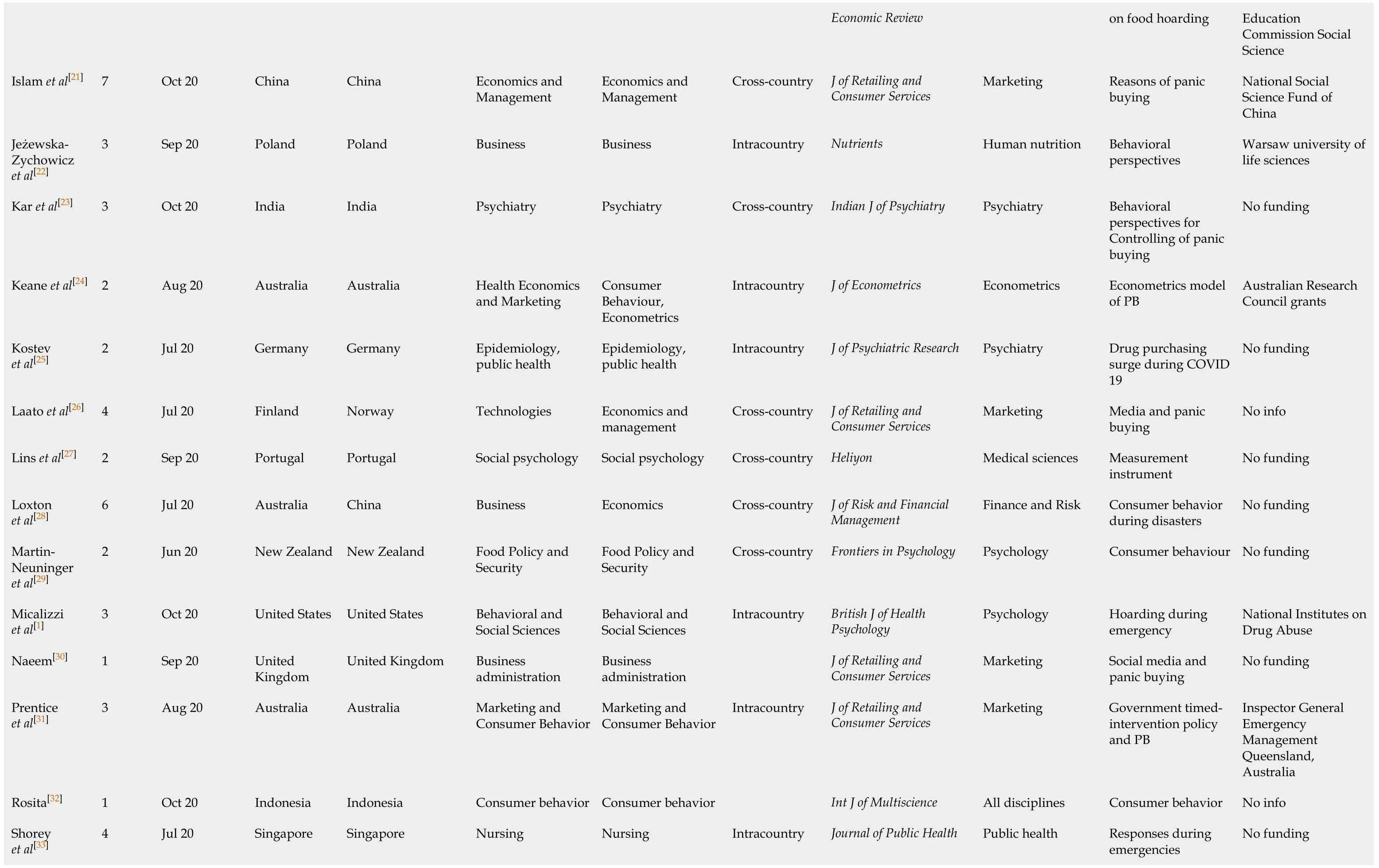
Economic Review on food hoarding Education Commission Social Science Islam et al[21]7 Oct 20 China China Economics and Management Economics and Management Cross-country J of Retailing and Consumer Services Marketing Reasons of panic buying National Social Science Fund of China Jeżewska-Zychowicz et al[22]3 Sep 20 Poland Poland Business Business Intracountry Nutrients Human nutrition Behavioral perspectives Warsaw university of life sciences Kar et al[23]3 Oct 20 India India Psychiatry Psychiatry Cross-country Indian J of Psychiatry Psychiatry Behavioral perspectives for Controlling of panic buying No funding Keane et al[24]2 Aug 20 Australia Australia Health Economics and Marketing Consumer Behaviour, Econometrics Intracountry J of Econometrics Econometrics Econometrics model of PB Australian Research Council grants Kostev et al[25]2 Jul 20 Germany Germany Epidemiology, public health Epidemiology, public health Intracountry J of Psychiatric Research Psychiatry Drug purchasing surge during COVID 19 No funding Laato et al[26]4 Jul 20 Finland Norway Technologies Economics and management Cross-country J of Retailing and Consumer Services Marketing Media and panic buying No info Lins et al[27]2 Sep 20 Portugal Portugal Social psychology Social psychology Cross-country Heliyon Medical sciences Measurement instrument No funding Loxton et al[28]6 Jul 20 Australia China Business Economics Cross-country J of Risk and Financial Management Finance and Risk Consumer behavior during disasters No funding Martin-Neuninger et al[29]2 Jun 20 New Zealand New Zealand Food Policy and Security Food Policy and Security Cross-country Frontiers in Psychology Psychology Consumer behaviour No funding Micalizzi et al[1]3 Oct 20 United States United States Behavioral and Social Sciences Behavioral and Social Sciences Intracountry British J of Health Psychology Psychology Hoarding during emergency National Institutes on Drug Abuse Naeem[30]1 Sep 20 United Kingdom United Kingdom Business administration Business administration J of Retailing and Consumer Services Marketing Social media and panic buying No funding Prentice et al[31]3 Aug 20 Australia Australia Marketing and Consumer Behavior Marketing and Consumer Behavior Intracountry J of Retailing and Consumer Services Marketing Government timedintervention policy and PB Inspector General Emergency Management Queensland, Australia Rosita[32]1 Oct 20 Indonesia Indonesia Consumer behavior Consumer behavior Int J of Multiscience All disciplines Consumer behavior No info Shorey et al[33]4 Jul 20 Singapore Singapore Nursing Nursing Intracountry Journal of Public Health Public health Responses during emergencies No funding
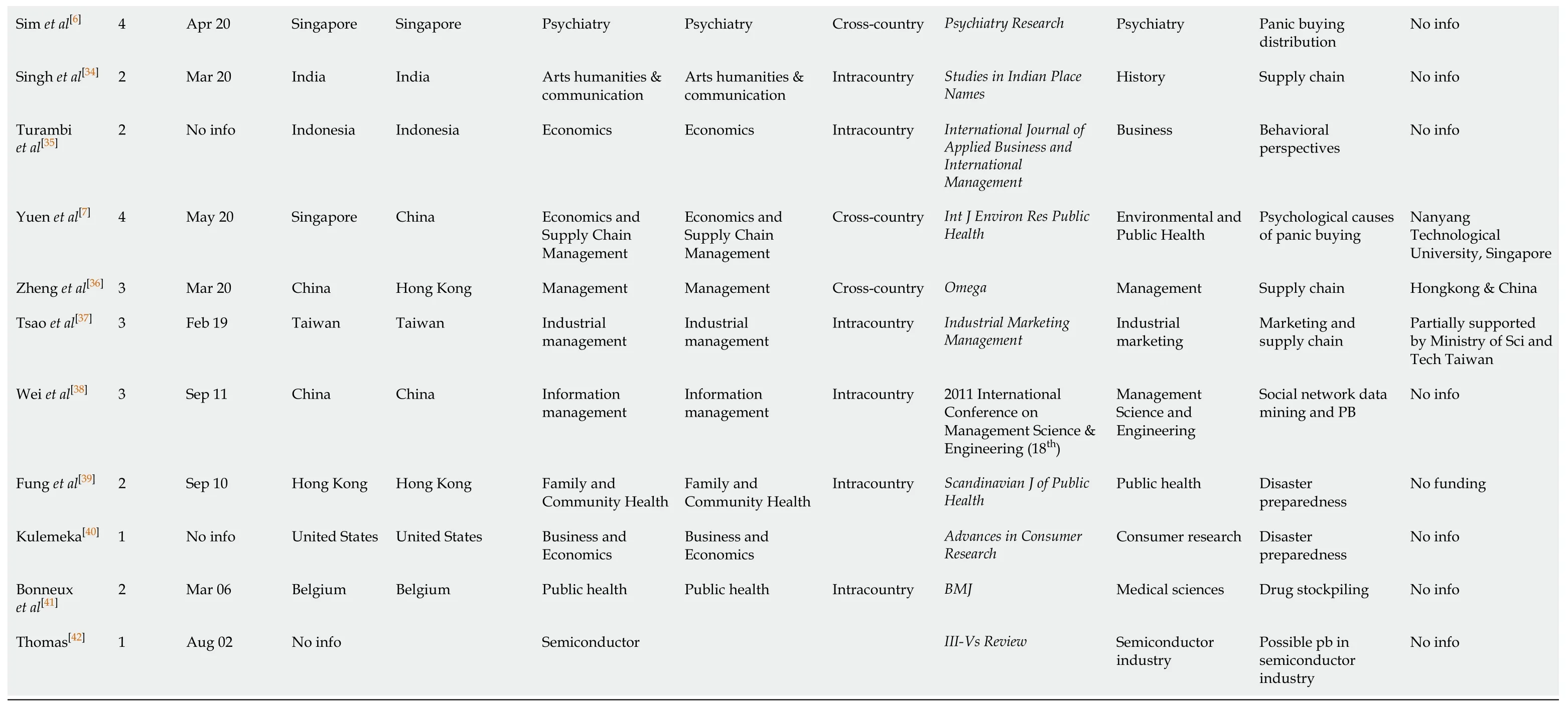
Sim et al[6]4 Apr 20 Singapore Singapore Psychiatry Psychiatry Cross-country Psychiatry Research Psychiatry Panic buying distribution No info Singh et al[34]2 Mar 20 India India Arts humanities & communication Arts humanities & communication Intracountry Studies in Indian Place Names History Supply chain No info Turambi et al[35]2 No info Indonesia Indonesia Economics Economics Intracountry International Journal of Applied Business and International Management Business Behavioral perspectives No info Yuen et al[7]4 May 20 Singapore China Economics and Supply Chain Management Economics and Supply Chain Management Cross-country Int J Environ Res Public Health Environmental and Public Health Psychological causes of panic buying Nanyang Technological University, Singapore Zheng et al[36]3 Mar 20 China Hong Kong Management Management Cross-country Omega Management Supply chain Hongkong & China Tsao et al[37]3 Feb 19 Taiwan Taiwan Industrial management Industrial management Intracountry Industrial Marketing Management Industrial marketing Marketing and supply chain Partially supported by Ministry of Sci and Tech Taiwan Wei et al[38]3 Sep 11 China China Information management Information management Intracountry 2011 International Conference on Management Science & Engineering (18th)Management Science and Engineering Social network data mining and PB No info Fung et al[39]2 Sep 10 Hong Kong Hong Kong Family and Community Health Family and Community Health Intracountry Scandinavian J of Public Health Public health Disaster preparedness No funding Kulemeka[40]1 No info United States United States Business and Economics Business and Economics Advances in Consumer Research Consumer research Disaster preparedness No info Bonneux et al[41]2 Mar 06 Belgium Belgium Public health Public health Intracountry BMJ Medical sciences Drug stockpiling No info Thomas[42]1 Aug 02 No info Semiconductor III-Vs Review Semiconductor industry Possible pb in semiconductor industry No info
Distribution of journals
The maximum number of pa pers were published in behavioral health (13: Psychiatry 9; psychology 4), followed by business (including marketing and management) (12), public health (4), and economics (3) (Table 2).Journal of Retailing and Consumer Serviceshosted the maximum number of papers on PB (4) followed byPsychiatry Research(2).
Distribution of keywords
A wide spectrum of keywords was found in articles with a prominence of COVID-19, PB, Coronavirus, and pandemic. Figure 2 shows the word cloud analysis of different keywords extracted from research publications on “panic buying.” Words with a larger font size refer to the most frequently used keywords and vice versa. Different colors are used to differentiate words from each other. Colors do not have any statistical significance.
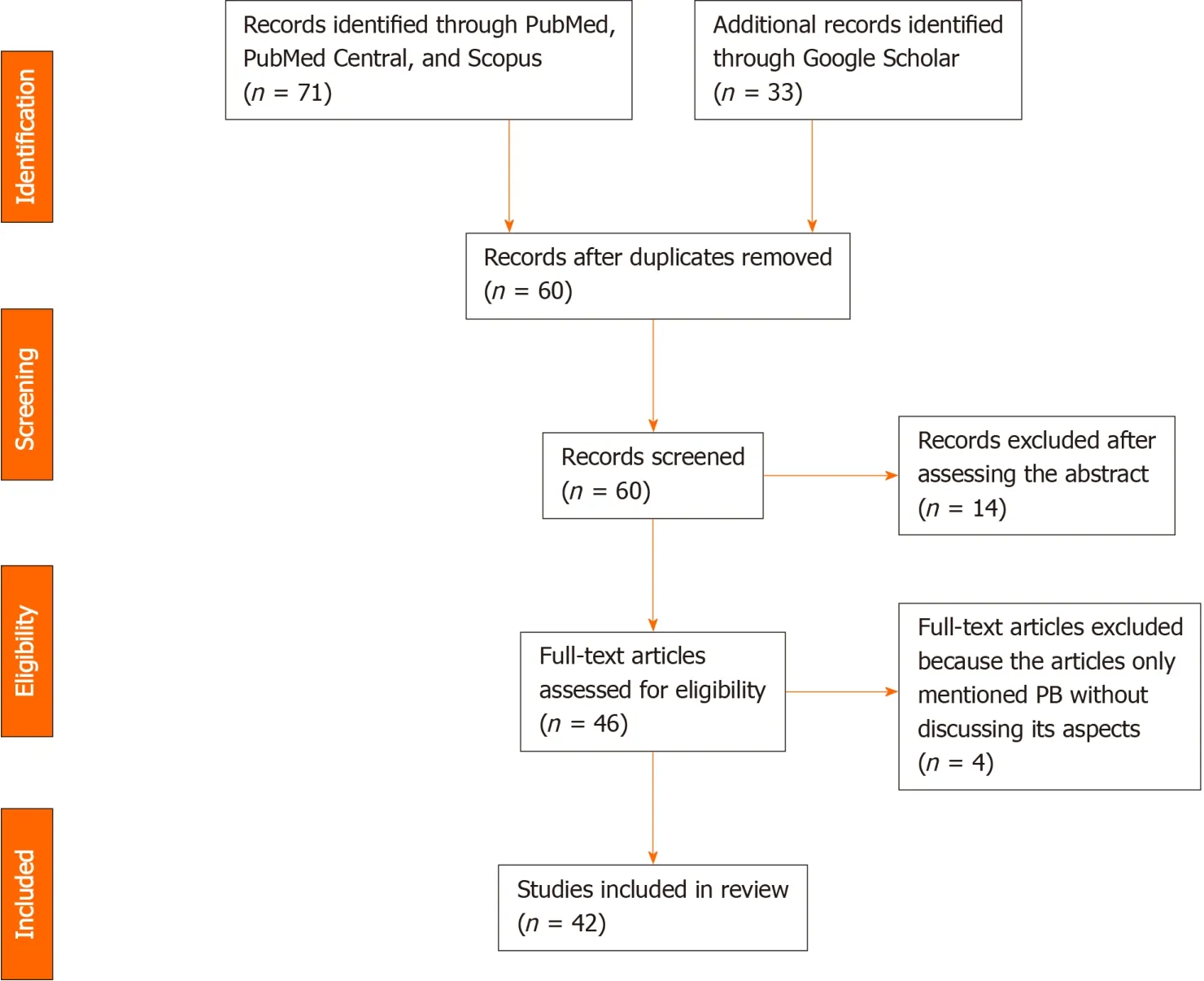
Figure 1 Preferred reporting items for systematic reviews and meta-analyses flow diagram.
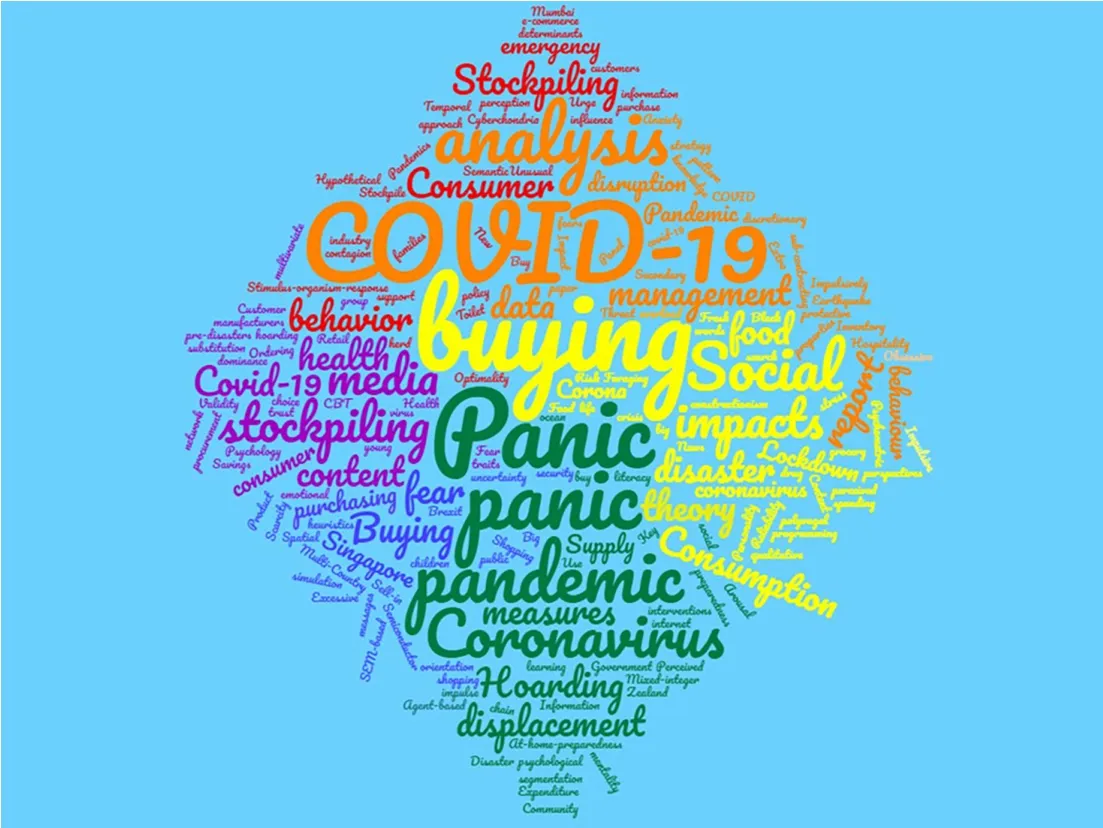
Figure 2 Word cloud analysis of key words.
DISCUSSION
We aimed to identify the aspects of PB already explored and research trends. We searched PubMed, PMC, Scopus, and GS with the search term “panic buying” on November 15, 2020. A total of 42 articles were collected and scrutinized (Figure 1). The type of research, publishing year, applied method, key findings, geographical distribution of the authors, specialty of authors, collaboration, subject of the journal, and research funding were assessed (Table 1 and Table 2).
Main findings
The main findings of the review revealed that some aspects of PB have been addressed such as the definition of PB[4], causative model[2], econometric model[21], media reporting of PB[3], responsible factors for PB[2], psychological reasons for PB[5-7], controlling strategy[8], measuring instrument[27], challenges to explore PB[9], and geographical distribution[2]. However, the methods were superficial that instigated further studies to replicate the observations.
Distribution of the studies
The study revealed that more than three-quarters (85.71%) of the research output on PB has occurred in the wake of the COVID-19 pandemic. This is an indication of the growing public health relevance of this phenomenon. More than sixty percent (64.28%) of the papers were original contributions indicating that the more empirical studies are coming out gradually (Table 1). Most of the studies applied survey and cross-sectional study design, which may be explained by the pattern of PB as it appears irregularly, episodically, and erratically in response to the adverse stimuli[2,9]. However, longitudinal studies are better in order to explore the behavior. Online media reports, social media, and Google Trends were also used, which may be explained by the COVID-19 pandemic, and the lockdown was applied.
Responsible factors
Several studies have looked at the etiological underpinnings of PB, mainly in terms of psychological and social factors that may contribute to the phenomenon[5-7]. The results are intuitive and point to the significance of perception of commodity and time scarcity, sense of uncertainty as well as the herd instinct, which has its basis in the social learning theory, as potential contributors to the genesis of PB[2,5-7]. Further, perceptions of price differential and price fluctuations have been found to correlate with PB behavior; this has implications from a management perspective and highlights the importance of maintaining supply chains.
Controlling measures of PB
Little empirical evidence is available on the management of PB. One group of authors proposed an online cognitive behavior therapy model for PB, but it was not tested[23]. The media should play a central role in curbing PB by spreading awareness about the phenomenon and adopting responsible reporting practices. A collaborative approach between the media, government, and health sector would foster a collective sense of responsibility and bring about sustainable changes in reporting practices, a key strategy to control PB[3].
Drawing upon these insights, it appears that PB can be controlled by adequate, timely, and consistent information on the evolving situation with an additional focus on clarifying misinformation or rumors. To reduce visual cues, big retail stores can encourage online shopping at least for those who are young/internet savvy. This will reduce long queues outside shopping stores, which is a visual signal for other buyers to join, and will reduce the possibility of such images being circulated in the mass media and social media, another important cue for PB[10]. Opening fair price shops where commodity prices are tightly regulated may be helpful in curbing panic purchases.
Academic domains
Researchers from several specialties took part in PB research, multiple academic domains have been researched, and articles have been published in several specialty journals such as psychiatry, psychology, business, sales and marketing, public health, supply chain, economics, management, consumer behavior, disaster preparedness, ecommerce, consumer behavior, marketing, prevention strategies, media, social network, economics, communication, information management, sociology, personality, nursing, health economics, food policy, epidemiology, community health, and engineering (Table 2). Consumer behavior patterns have been studied during different situations such as pandemic[28]and seasonally recurring disasters[40]. Insights from these studies can be used to spread awareness about PB, facilitate the identification of hoarders, and take steps to mitigate supply chain disruptions[37]. Reducing conflicting information from different media sources and giving advance information about impending seasonal disasters would assist people in staggering their purchases and reduce eleventh-hour PB. Concordance of information from media sources is likely to promote trust in the media, a key element that has been linked to an increased likelihood of distress purchases[22].
Distribution of authors
Most of the authors were affiliated with institutions from Australia, Bangladesh, China, India, Singapore, and the United States (Table 2). The fact that more than half of the studies reviewed originated from Asia may reflect the proneness of countries in the region for PB, probably due to a combination of structural issues, public mistrust, and lack of adequate governmental action. More than forty percent (42.85%) of the papers had intercountry collaborations signifying the common interest of the research. Among the 10 funded projects, China had the highest funding (3 full; 1 partial); Australia (2), Hong Kong (1 partial), United States (1), Poland (1), Taiwan (1), and Singapore (1).
Strengths of the study
This is the first systematic approach to provide an overview and identify the research gaps on the emerging research topic. Only peer-reviewed published articles were reviewed.
Limitations
The search was done cross-sectionally by a single individual (first author). Only articles published in the English language were included. Preprints were not included.
CONCLUSION
PB is a relatively newer concept to get the attention of the research community. The study revealed several important aspects of PB research including research trends, major studied areas, geography, collaboration, and funding of studies. This review would help policymakers, researchers, funders, and other stakeholders to shape their decision while studying PB. Further robust studies with replication of the findings are warranted to fill the research gaps identified in this review.
ARTICLE HIGHLIGHTS
Research background
Panic buying is an under-addressed research entity.
Research motivation
Sporadic evidence is coming out in recent days.
Research objectives
We aimed to see the perspectives of panic buying that have been studied through November 15, 2020.
Research methods
We did a systematic search in PubMed, PubMed Central, Scopus, and Google Scholar and reviewed 42 articles.
Research results
The study identified the distribution of study, aspects of panic buying, academic domain related to panic buying, distribution of authors, the specialty of the authors and journals, funding, and collaborations of the identified articles.
Research conclusions
Although the study identified some important perspectives, further studies are warranted in a systematic manner.
Research perspectives
The review provides a good insight into the different stakeholders to plan further studies and prevent panic buying.
 World Journal of Meta-Analysis2020年6期
World Journal of Meta-Analysis2020年6期
- World Journal of Meta-Analysis的其它文章
- Comparison of hand-assisted laparoscopic radical gastrectomy and laparoscopic-assisted radical gastrectomy: A systematic review and meta-analysis
- Split-dose vs same-day bowel preparation for afternoon colonoscopies: A meta-analysis of randomized controlled trials
- COVID-19-associated stroke risk: Could nutrition and dietary patterns have a contributing role?
